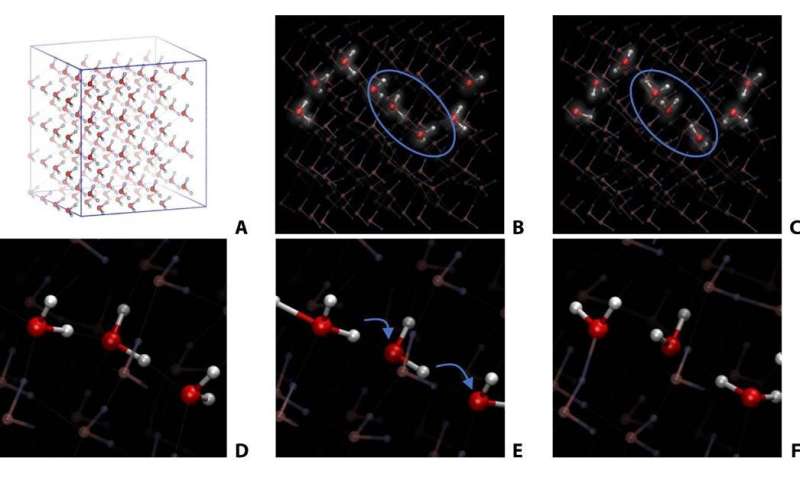Researchers observe protons 'playing hopscotch' in a high-pressure form of ice
by Science X staff
An international team of researchers from University College Dublin (UCD) and University of Saskatchewan, Canada, have observed 'proton-hopping' movement in a high-pressure form of ice (Ice VII lattices).
Such movement may be present in planetary bodies such as Venus, along with Jupiter, Neptune and Uranus, and their moons; or exoplanets (planets outside the Solar System), mediated by external electric fields.
This electric-conduction-in-ice discovery has the potential to alter and enhance our understanding of the behaviour and molecular dynamics of high-pressure ice in the Universe, in all its different forms and varied environments.
The discovery has been announced in a scientific paper titled "Possibility of Realising Superionic Ice VII in External Electric Fields of Planetary Bodies," just published in Science Advances, a peer-reviewed, multidisciplinary, open-access scientific journal.
Ordinary water ice is known as Ice I, while Ice VII is a cubic crystalline form of ice which can be formed from liquid water above 3 GPa (30,000 atmospheres) by lowering its temperature to room temperature, or by decompressing heavy water (D2O) Ice VI below 95 K.
Ice VII has a simple structure of two inter-penetrating, and effectively independent, cubic-ice sub-lattices, and is stable across a wide-ranging region above 2 GPa. Given Ice VII's simple structure and stability its importance as a potential candidate for a superionic (SI)-ice phase, in which Oxygen atoms remain crystallographically ordered while protons become fully diffusive as a result of intramolecular dissociation, has been hypothesised for some time.
In addition, theoretical studies indicate possible SI-ice prevalence in large-planet mantles, such as Uranus and Neptune, and exoplanets, or those featuring permanent or transient electric fields, such as Venus.
The challenge for scientists to date has been to realise SI-ice and the discovery of protons 'on the hop' in Ice VII was made by Professor Niall English, UCD School of Chemical and Bioprocess Engineering with his then postdoctoral research fellow, Dr. Zdeněk Futera, and paper co-author, Professor John Tse, University of Saskatchewan.
Professor Niall English, UCD School of Chemical and Bioprocess Engineering, said, "Our new fundamental discovery involves the application of electric fields, which induce proton separation from their constituent parent water molecules, and Grotthuss-type 'proton hopscotching' from one water molecule to the next, displacing the proton on the next chain in a game akin to musical chairs, thereby establishing an electric current or a flow of charge."
He added, "This has important implications for hypothesised Ice VII in various planetary and exo-planetary bodies, featuring permanent or transient electric fields, such as the environs of Venus and moons of Jupiter such as (water-rich) Europa, and, especially, Ganymede."
"This development in ice physical chemistry has the potential to lead to possible spectroscopic detection of exotic phases of ice in the universe."
The underlying (non-equilibrium) molecular-simulation approaches in external electric fields are promising in terms of their potential use in designing superior charge-transport materials for solid-state device physics.
Dr. Zdeněk Futera, now at the University of South Bohemia, Czech Republic said, "Leveraging ongoing research collaboration programmes with Professor John Tse, University of Saskatchewan, we have established a good theoretical understanding of electric fields' molecular manipulation of protons' conduction, which contributes to our microscopic knowledge of charge flow."
Professor John Tse, Department of Physics and Engineering Physics, University of Saskatchewan, said, "Our work elucidates the atomistic and electronic origins for SI behavior in Ice VII, which mimics the recent laser-shockwave experiments of Ice XVIII by Millot and co-workers published in Nature one year ago. In the Universe, we note that Venus has a permanent electric field, which may be expected to influence heavily the microscopic behavior of any water thereon."
"The explanation also accounts for why these protons can be seen to hop along when an electric field is applied. Thus, this study is able to provide a clear and consistent explanation to a previously puzzling problem—the 'how and why' of making ice superionic."
Professor English concluded, "We would like to acknowledge the High-Performance-Computing support and facilities provided at UCD as well as the collegiality of visionary practitioners in the ice-physics global community."
More information: Zdenek Futera et al. Possibility of realizing superionic ice VII in external electric fields of planetary bodies, Science Advances (2020). DOI: 10.1126/sciadv.aaz2915
Journal information: Science Advances , Nature
Provided by University College Dublin